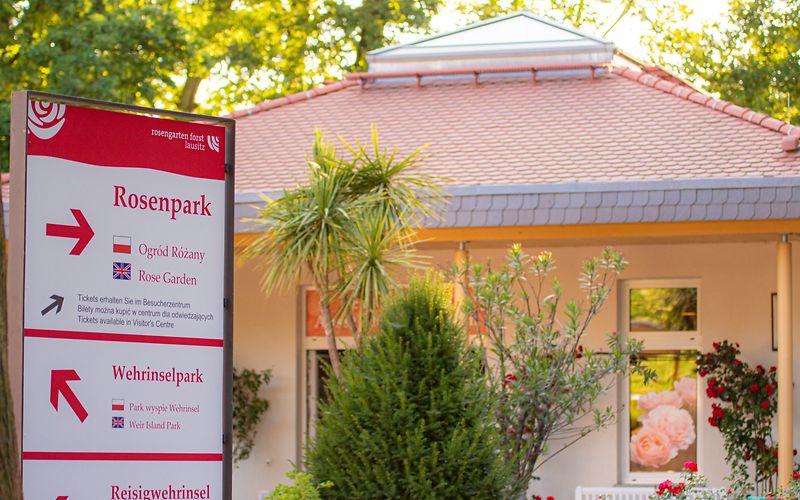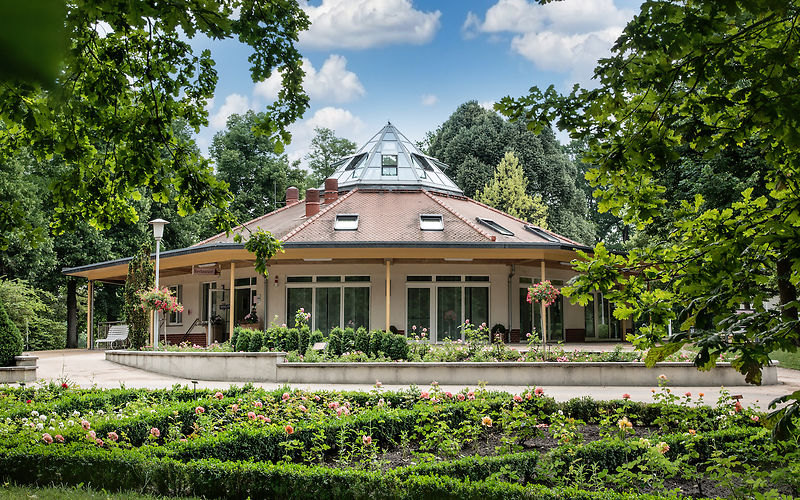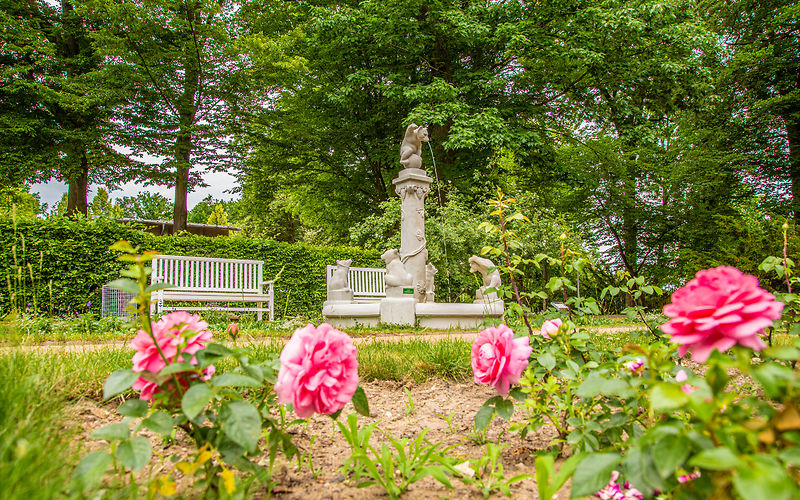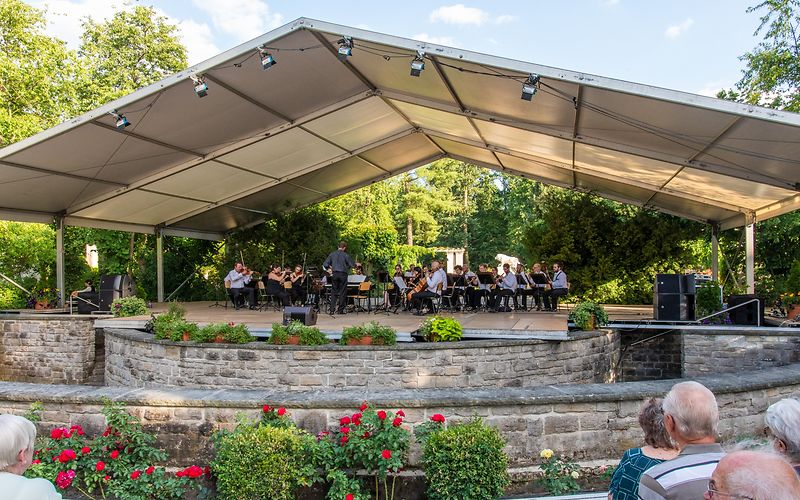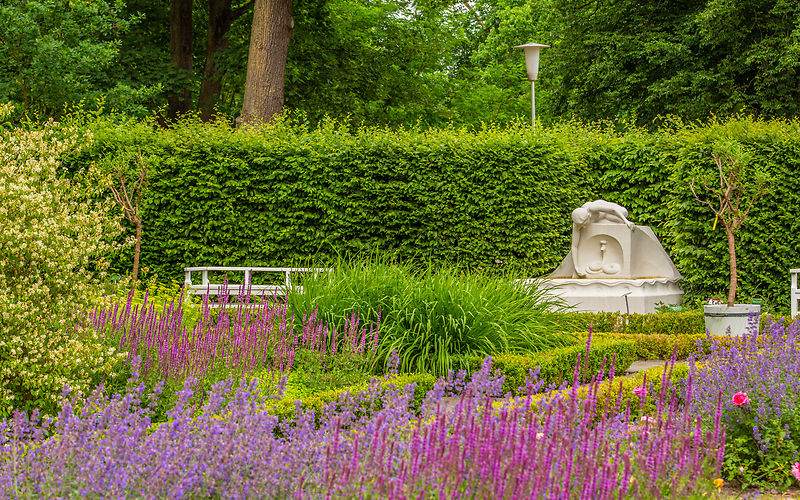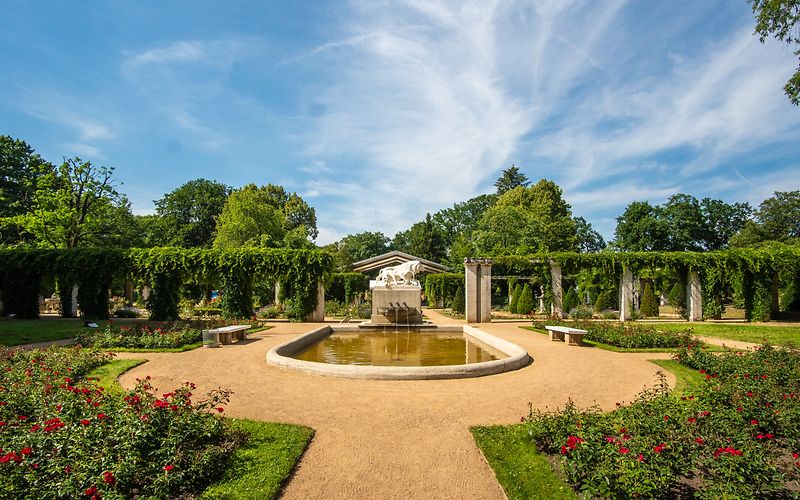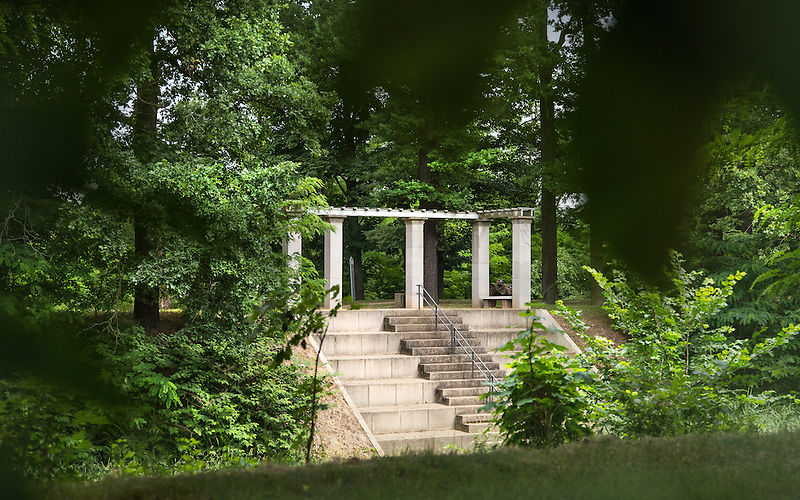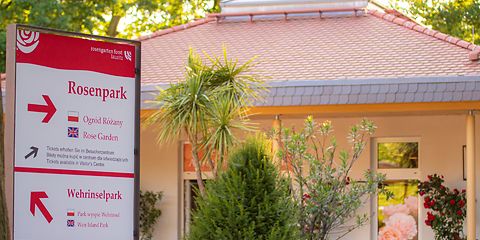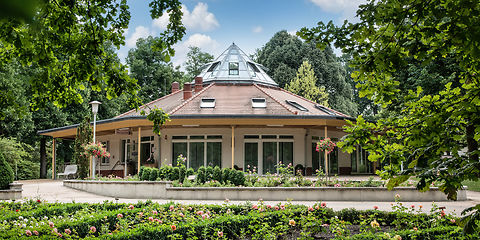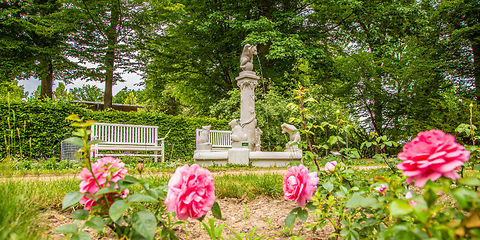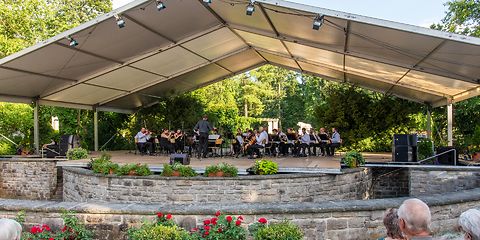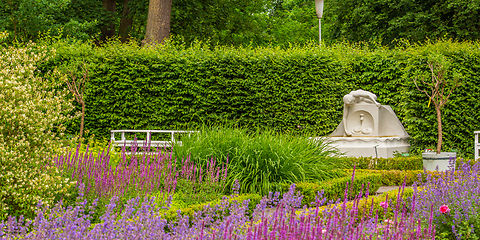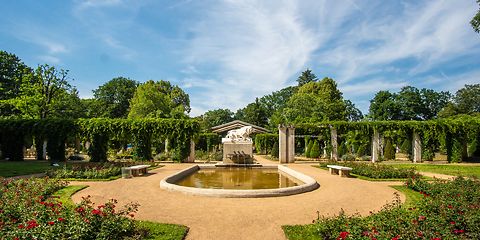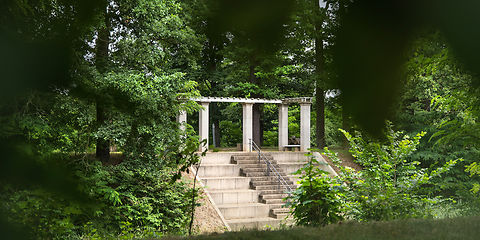Weir island park
This park area is designed in the English landscape style. Its grand old trees and the light green of the extensive lawns invite relaxing walks. The focal point is a pergola courtyard with an enchanted fairy-tale atmosphere. In the event centre on the Wehrinsel, the Rosenflair restaurant awaits guests with its excellent gastronomy. The Sleeping Beauty Park playground is a treat for the youngest visitors.
Explore the Weir Island Park
We warmly recommend the park guide for those wishing to take in the park’s diverse features and areas under their own steam. It is available at the ticket offices as a brochure, or as an audio guide.
Twenty themed stations installed around the park complex allow visitors to gradually explore the historical site and gain fascinating insights and background information along the way.
Read about the Weir Island Park at Stations 11–17:

The visitor and exhibition centre was rebuilt for the 2013 centenary. During the Rose Garden season from May to the end of September, the ticket office at the northern entrance to the rose park is located here as well as the visitor service centre and souvenir shop. In addition, changing exhibitions with regional, historical and cultural themes are held in the visitor centre during the Rose Garden season. Above all, however, the rose is at the forefront.
The seasonal climax of the Rose Garden festival each year is on the last weekend of June when the hall hosts the traditional exhibition of cut roses. Here, with a different motto every year, regional florists display fascinating creations based all around the rose. For the occasion, they decorate the 200 square metre exhibition hall with an average of 2,000 to 3,000 roses in around 70 varieties. Various other exhibitions take place here before and after this event.
The previous building at this site was an important event venue from the time of its construction in 1954. In addition to the annual exhibition of cut roses, the building also served the Forst registry office as a wedding room where many couples made their vows. The function of registry office was integrated into the new event centre when it and the nearby restaurant were built.
A farm building immediately to the west existed here until World War II. The site where the hall now stands was used for horticultural purposes, presumably as a nursery storage or cultivation area.

The event centre opened in 2008. It was constructed on the site of the Wehrinsel restaurant, built in 1910. The centre accommodates the Rosenflair restaurant with its very good regional cuisine, an event hall with up to 160 conference seats, and a wedding room for the Forst registry office. Here weddings can be celebrated all year round against the magical backdrop of the historic park.
The embankment around the building used to be crowned with lime trees. The elevated area in front of the building and the space in front of the embankment to the west and south were used as a beer and concert garden. After the Rose and Garden Show of 1913, the beer garden had a view of the Rosenhof (Rose Courtyard) to the south and the music pavilion to the east.
The interior of the restaurant was renovated in 1926. Modern utilities were installed (central heating, hot water, gas, etc.), the veranda was turned into a conservatory and all the rooms were repainted and furnished. It was ranked as one of the most modern and beautiful restaurants in Lusatia.
In 1938, the concert garden south of the Wehrinsel restaurant seated about 3,000 visitors.
The restaurant was destroyed in World War II, but it was rebuilt on the still existing foundation walls within a few weeks in 1953 as part of East Germany's national reconstruction programme. A memorial plaque on the building, later lost, commemorated this local reconstruction project for many decades. The population played an important part in rebuilding the restaurant, both financially in the form of donations and practically in the form of voluntary work.

A special feature of the East German Rose Garden is the design elements that have shaped the park in its historical development. A wide variety of art objects from past decades can be found everywhere, including a number of fountains and sculptures by Cottbus stucco sculptor Walter Adler from the early days of the park. The Bear Fountain on the Wehrinsel was also produced in his workshop.
Walter Adler can be described as a tragic figure of the 1913 Rose and Garden Show. In addition to the Bear Fountain, he created the Rose Fountain with Flora at the main entrance, the Snake Fountain with the boy scooping up water in the Garden of Fragrances, various cups and decorative vases, and other figures that are no longer preserved today. Walter Adler died on 14 October 1912 and therefore did not live to see the great success of the Rose and Garden Show nor the popularity of his works.
The fountain features four bears sitting on the edge and playing with the water. Another bear sits on a column in the middle, raising his right paw. One of the four bears looks at the pool and wipes water from his fur with his left paw, while the other three look up at the bear in the middle who spouts water from his mouth. He sits on a ball high on the vine-decorated central column, like the leader of the cheerful scene. Originally, only the two bears sitting in front of the column were designed for the fountain. The pedestals at the back were initially decorated with two planted bowls, but within a few years the bowls were replaced by replicas of the bears.
The fountain was partially destroyed at the end of World War II. Since the shape of one of the bears looking upward remained intact, it was possible to make replicas at a later date.

One of the first things associated with roses is of course the fragrance. The Garden of Fragrances contains a collection of herbs, perennials and shrubs with a wide variety of scent characteristics. Led by an assortment of roses, accompanied by shrubs and complemented by classic aromatic plants such as sage and lavender, this is truly agarden of the senses, delighting both sight and smell with its magic.
The basic layout of the Garden of Fragrances with its Snake Fountain goes back to 1913 at which time it was completely planted with roses. At the Rose Show of 1938, it was designated as a special rose garden. Owing to the slab-like structure of the concrete paths, the term slab garden was used during the era of East Germany. The designation summer flower garden on a 1986 site plan indicates that this was how the garden was used in the 1980s and 1990s. The garden acquired its current arrangement of fragrant vegetation in the centenary year of 2013.
The Snake Fountain with the water-scooping boy is the third of the fountains created by Walter Adler in the founding period of the garden, which were renovated in 2018 with the aid of funds from a gambling tax on lotteries and sports betting in the state of Brandenburg. Surrounded by a wide variety of summer flowers and shrubs, it is particularly eye-catching and provides a special backdrop for the fragrant beauties that vie for your attention here.

The Schiller Stage is located on the northern edge of the Pergola Courtyard. Formerly the site of the Lion Fountain, performances were held here for the first time at the 1939 Rose Garden Festival. The abandoned base of the former lion group was used for this purpose and the basin of the lion fountain was covered with large wooden panels as a stage area. An orchestra pit was created and the seats were initially arranged at ground level.
In 1954, the orchestra pit was repaired and the spectator area was rebuilt with bench seating. With room for an audience of 1,000, it offered good seating and listening conditions. It was named Schiller Stage a year later, on the occasion of the Schiller Year celebrated nationwide to commemorate the 150th anniversary of the death of the great poet. The East German leadership saw in Friedrich Schiller a progressive citizen and thus a suitable unifying figure to build up an East German national identity. The stage received its name on- July 3rd 1955 in a solemn ceremony during the festival week, in conjunction with a Schiller evening organised by the Cottbus State Theatre.
For the annual Rose Garden festival, the stage and part of the audience area are provisionally roofed over. It offers an extraordinary setting for cultural events such as open-air summer theatre and cinema, concerts and large choir performances.

Although it has changed over the decades, the Pergola Courtyard was one of the most important architectural structures of the Forst 1913 Rose and Garden Show. The courtyard is, so to speak, the reception room of the Wehrinsel. The pergolas are draped with Virginia creeper and wisteria. The Pergola Courtyard was completely restored on the occasion of the 90th anniversary in 2003 with the support of the promotional association Ostdeutscher Rosengarten e. V.
The Lion Fountain with its group of thirsty lions was a magnet for visitors to the Rose and Garden Show in 1913. The Forster Tageblatt newspaper praised the structure as the most beautiful ornament of the Rose Courtyard and as one of the most magnificent and sublime works of art on the site ... Lion and lioness make a beautiful impression, viewed from near and afar. Only the leg positions of the group could have been more clearly defined. The body shapes of the animals are splendidly formed.
The lion group disappeared without a trace after the show of 1913; presumably sold. The base of the original and the adjacent fountain block existed until around 1938 or 1939. The original location was built over by the Schiller Stage in 1953. Thanks to the extensive support of numerous sponsors on the centenary of the East German Rose Garden, the Lion Fountain now shines in new splendour on the opposite side of the Pergola Courtyard.
Another of the main features of the Rose Garden is the Frog Fountain on the west side. Five small pillars support a round water basin. In the middle sits a frog on a mushroom-like base with water spraying out of its raised mouth. Stucco artist Gustav Hagedorn and civil engineer Erwin Lemsky from Guben were awarded the second prize as an honorary award by the town of Forst for this fountain made of artificial shell limestone.

From the monumental staircase on the Wehrgraben, there was originally a wooden footbridge that connected the Wehrinsel with the northern part of the Reisigwehrinsel until World War II. Although the remnants of the old concrete bridge foundations are somewhat overgrown, they can still be seen in the embankment. During the preparations for the centenary of the East German Rose Garden, an idea was to reconstruct the bridge and thus offer a more varied route around the Reisigwehrinsel.
Unfortunately, it was not possible to find a solution that met with official approval. From the point of view of the authorities responsible for flood protection, the bridge construction would have had to be above the cross-sectional profile of the site, but this was out of the question for the authorities responsible for heritage protection.
The stairs and terraces that were subsequently built now have a more creative and symbolic function. The link between the two islands is clearly emphasised, but of little practical use. The pergola on the Reisigwehrinsel takes up the architecture of the Pergola Courtyard and thus emphasises its central axis. Seen from the Wehrinsel, the pergola on the Reisigwehrinsel is a visual eyecatcher making it seem like you are gazing through a picture frame at the landscape towards the east.



